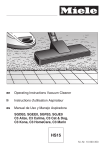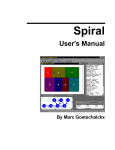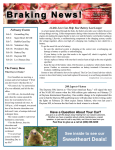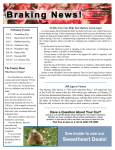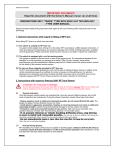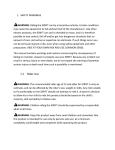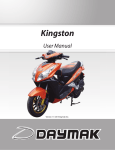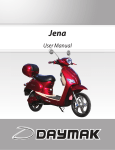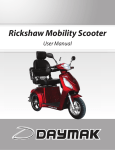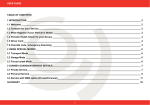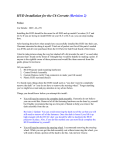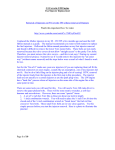Download Essential Auto Maintenance
Transcript
[student name withheld] 4212 / T. Roberts, Instructor Assignment 4 / 3 December 2011 Essential Auto Maintenance A guidebook for a simple, affordable way to sustain your vehicle. The day you purchased your vehicle, what did you choose to name it? Did you imagine how you would fill it with gas and wash it by hand? Did you picture yourself underneath changing the oil and jacking it up to rotate the tires? Performing your vehicle's maintenance saves you money, keeps your vehicle operational, and aids you in tough road-side situations. One question still lingers--can anyone perform these tasks within a practical amount of time? After spending a couple hours in the driveway with Dave Gill and a silver Versa named Ursula, I can honestly say that anyone can learn and apply these instructions. I will lead you through each step—from what bolt to how tight. Furthermore, I guarantee you will experience satisfaction and even enjoy your own blunders. Six-Step Fluid Check The simplest maintenance task is the best area to begin a fluid check. All fluid reservoirs are located under the hood of your automobile. Check your vehicle’s fluid every month. Coincide a fluid check with paying your auto insurance--they are both essential to you and your vehicle’s well-being. What you Need o o Paper Towels Automobile Instruction Manual or laptop if you do not have the manual Getting Started Park on a large flat surface, and turn off the engine for at least 30 minutes prior to fluid check. Fluid 1: Oil With paper towel in hand, pull out the oil dipstick completely and wipe off the wire strip. Replace the oil dipstick then pull it out again to examine the end. The wire strip will have two holes or two lines for the minimum and maximum oil measure. If the oil is low, and you change it regularly, then you need to take your vehicle to your mechanic (Gill). [student name withheld] – ENC 4212 – Assignment 4 – 3 December 2011 – Page 1 Fluid 2: Washer Fluid Washer fluid cleans the windshield and dries the morning dew. Washer fluid costs a dollar per jug on sale, so carry one in your vehicle. You don’t want to get stuck in the rain behind a large truck spitting mud up on your windshield. Simply unscrew the cap with a windshield washer image on it and use a funnel to pour in the new fluid. Fluid 3: Transmission Fluid Note: Most vehicle manuals suggest checking the transmission fluid while your vehicle is running. Checking transmission fluid is similar to checking the oil. Transmission fluid is in a reservoir. A ring-shaped pull will be peeking out of a place deeper into the engine area. This pull has a wire strip attached with two lines or dots, just like the oil dipstick. Pull out the transmission dipstick and wipe it off with a paper towel. Replace the dipstick, and this time pull it out to check where the fluid line is on the wire strip. If the fluid mark is between the minimum and maximum, then your transmission will most likely fall out within the next couple of weeks. Just kidding, your fluid has no bearing on the transmission falling out. If the fluid is low, check your auto manual for what fluid to buy before heading to the auto-parts store. Don’t forget to use the funnel when you pour it in. Fluid 4: Radiator Fluid Warning: It’s imperative to check the coolant after the automobile is cool and the fluid has had time to return to the tank. If your vehicle is running, then you risk being sprayed by 200-degree liquid under pressure (Gill). Radiator fluid (Coolant) keeps your engine from freezing and from boiling over. Radiator fluid is usually stored in a large opaque tank, called the overflow reservoir, with two apparent lines on the outside for the minimum and maximum. If the coolant is low, purchase more at any auto-parts store. You can purchase coolant diluted or concentrated. Pour the diluted mix directly in the reservoir. For concentrated coolant, mix water with coolant as directed on the jug before pouring it in the reservoir. If you are caught with low coolant, and no fluid to replace it--pour in bottled water. When using water, record the amount you pour in, so you can purchase concentrated coolant and accommodate for the previous dilution later. Fluid 5: Brake Fluid The brake fluid is in an opaque reservoir with evident lines for minimum and maximum. The brake fluid reservoir is similar to, but smaller than, the radiator reservoir. To purchase brake fluid, check your automobile manual, but any generic brake fluid will work (Gill). “Fluid” 6: Air Filter Wait, an air filter isn’t fluid, but it is worth checking. As Dave says, “a dirty filter cuts down on the proper amount of air flowing into the engine to support combustion. This will lead to a rough running engine, or at the very least, reduced fuel economy.” It is extremely simple to pull out and examine. If you can see dirt on it, then replace it. It will need replacing every two-three years (or 20,000 miles), or more often if you travel on dirt roads (Gill). The product specifications for the filter are listed on the used filter. A new filter typically costs less than ten dollars. Troubleshooting If any fluid is extremely low, then you possibly have a leak. Take your vehicle to your mechanic for service. Oil Change What Does Brake Fluid Do? Dave explains brake fluid by saying, “In simple terms, when you step on the brake, you are pushing a plunger through the brake master cylinder. The brake fluid reservoir sits on top the master cylinder and keeps it supplied with fluid. This plunger pushes brake fluid through brake lines to the brake on each wheel. The pressure inside each brake causes it to pinch against the wheel, slowing it down. If you get so low in the reservoir you push air into the brake lines, you will have no brakes.” I believe brake fluid now comes first on my fluid check-list. Oil is essential to your vehicle. When your automobile is running, oil is pumped out of the reservoir, over the engine, and through all of the engine components. Oil keeps the tightly fitted engine parts lubricated and clean. The oil retains dirt as it cleans your vehicle’s engine, so change the oil and filter every 3,0005,000 miles. You can change your automobile’s oil and filter in this nine-step process. Practice will ensure a faster oil change; however, allow 90 minutes for your first experience. What you need o Automobile User Manual or your laptop if you have no manual o Tire Ramps purchase at any auto-parts store for approximately $30 [student name withheld] – ENC 4212 – Assignment 4 – 3 December 2011 – Page 2 Synthetic versus Non-Synthetic/Standard Oil o Oil Filter check your auto manual, it should be three or four dollars. o Oil Filter Wrench Adaptor forms a Extreme temperature does not cap over the oil filter. Buy at an affect viscosity auto-parts store for $6 Four times the price of standard o Towel for a slightly softer area under your auto Standard is the right choice for most cars, as long as you change o Oil Drain Pan bucket for capturing the oil often (Gill). used oil. Purchase at an auto-parts store for $10 Viscosity How thick or thin the oil viscosity is depends on o Paper Towels one roll is enough, but temperature. Standard oil thickens in cold weather, and thins out in for the first time bring two…just in hot weather. It’s a good idea to run your vehicle a few minutes prior case to entering on an extremely cold day. o Socket Wrench Set for the oil pan. Purchase for about $20 at an autoparts store o Fresh Oil determine the type of oil from the automobile user manual. Cost is $15 per oil change o Funnel splurge the extra three dollars on an automobile funnel. o Milk Jug an empty milk jug. This one is free! o Zip-Lock Bag gallon size o Garbage/Recycle Truck & Worker for taking away your oil leftovers Change every 5,000 miles Superior quality Change every 3,000 miles Can cause oil sludge if not changed regularly Extreme temperature affects viscosity Inexpensive (about $1.20/qt.) Getting Started Gather all the tools listed above, and park your automobile on a large flat surface. Begin with a cool engine. Step 1: Climb the Ramps Filter Cap versus Adjustable Filter Wrench Place ramps directly in front of the two front wheels, aligning them for a short straight climb. Find a helper to direct you as you climb the ramps. Start slow and do not stop halfway up the ramps. A steady climb is necessary. Ramps are built to keep your car from driving off the end, but as you can see, they do not always live up to this task. I bet Ursula likes me already. Step 2: Open the Crank Case Ventilator The crank case ventilator is positioned differently depending on your vehicle. It has an oilcan symbol on the cap. Simply unscrew and remove. Removal is critical for Step 6, when we drain the oil. Price $6 Easily reaches tight areas Fits many generic filters Step 3: Remove the Shroud Select automobiles have a plastic shroud underneath the auto that shields the engine from dirt (Gill). Most shrouds are attached with bolts. Unscrew the bolts. If your vehicle has no shroud, move on to Step 4. Price $7 Less-efficient in tight areas Fits a wider range of filter sizes Step 4: Remove Used Oil Filter It is time to examine the underside of your vehicle, so roll out the mat and lay down. Locate the used oil filter. As seen in the photograph, it protrudes out of the lower side of the engine, pointing towards the front of the vehicle. Place the socket wrench snugly over it. Position the oil drain pan underneath the filter, and loosen the filter a quarter-turn. You should now use your hand to loosen and release the old filter. About a half-cup of oil will drain into the bucket. Pour the filter out into the drain pan. Lay the used oil filter in the drain pan. Step 5: Replace with New Oil Filter Rub the underside of the filter (called the gasket) with some oil from the drain pan. This lubricates the gasket (Gill). Screw the new filter on with your hand, tightening as much as possible. Then place the socket wrench over the filter and tighten a quarter-turn. Do not over-tighten. If the filter is loose, then your car will release droplets of oil within [student name withheld] – ENC 4212 – Assignment 4 – 3 December 2011 – Page 3 ten minutes of ignition. The solution is another eighth-turn with the socket wrench. Clean up any oil on your vehicle with paper towels. If necessary, use kitty litter as an inexpensive way to pick up oil off of a driveway (Gill). Step 6: Drain the Oil Pan Continue your horizontal relationship with the towel for this step. Locate the oil pan, which is directly under the engine (see photograph). Don’t confuse this with the transmission pan (Gill). A distinct bolt projects from the lowest part of the oil pan. Loosen this bolt just an eighth-turn. Situate the oil drain pan under the bolt, and use your fingers to loosen and Remembering to Change the Oil release. This time the oil will pour out for a few minutes before it slows. Because we opened the crank case ventilator earlier, Mechanics and vehicle-owners, like you, write the the oil drains faster. If you did not open the crank case mileage on the new oil filter. However, if you don’t grace ventilator, see Step 2. After ten minutes, replace the bolt. Twist the underside of your vehicle often, then I suggest the it on with your fingers until tight, then add an eighth-turn with following tricks the socket wrench. Once again do not over-tighten the bolt. Wipe your vehicle clean of residual oil using paper towels. Step 7: Replace the Shroud Avoid popping a tire by replacing all bolts in the shroud. If a popped tire occurs, read section three about changing your tire. Now, get up from underneath the vehicle! Step 8: Pour In the New Oil o o o o Write a note on your calendar 90 days away Input a notification in your cell phone Plan to do car maintenance each season Record mileage on a window cling, available at any auto-parts store Keep a log in your glove compartment, recording maintenance done and date (Gill) o Remember the crank case ventilator you opened earlier? It has the oil can symbol on the cap. Locate that opening, because that is where you will pour in the new oil. 1-Check your automobile manual for the amount of oil that your oil pan will hold. However, Dave Gill states, “four quarts is a good starting point.” Place the automobile funnel into the crank case ventilator hole. Pour in the oil. Replace the cap on the crank case ventilator. Remove any additional objects surrounding or underneath the car (e.g. oil drain pan). Start the car and carefully back down off the ramps. Note Starting the car at this point in the process is important to revive the oil movement over the engine (Gill). Finally, re-examine the oil dipstick to ensure the proper measure of oil is in the oil pan. Step 9: Recycle Used Oil and Filter Your mission is nearly complete! The oil drain pan is reusable, but you need to drain the used oil immediately. Use the automobile funnel to drain the oil from the oil drain pan into the empty milk jug. To recycle the used oil filter, zip it up tightly in a zip-lock bag. Deposit the milk jug and zip-lock bag on the curb for garbage/recycle pick-up. Troubleshooting I can’t loosen my oil filter. What happened? Answer You probably tightened your oil filter too much when you changed the oil last time. If you used a filter cap to remove the filter, then try using an adjustable filter wrench. These can supply more torque and will usually loosen the filter. I drained my oil, but the dipstick still indicates it is full! Help! Answer You actually drained the transmission fluid instead of the engine oil. Now you get to crawl under the car again and do it right. You will also need to replace the transmission fluid you drained. Why do I see drops of oil on my driveway after doing an oil change? Answer You will need to get back under your vehicle to see where the oil is leaking from. If it is the oil pan, then tighten the drain plug bolt another one-eighth turn. If it is the oil filter, then tighten it another one-eighth turn. If oil is still leaking, then remove the filter and check that the gasket is straight. You will lose some oil when removing. I followed all your directions, but when I went to drive away, my remote keyless entry doesn’t work anymore. Answer It happens to me all the time. You changed the oil in your neighbor’s car by mistake. (Gill) Tire Change and Rotation Your vehicle’s tires are vital to travel. A blown tire means calling a tow truck--a pricey adventure. Rotating your tires is another way to protect the tread (leading to a longer life). You can achieve these actions through learning the simple removal and replacement process. What you Need o Tire Pressure Gauge for checking the PSI. Digital versions available for 13 dollars o Flathead Screwdriver to remove the hub cap, if applicable o Towel for a softer surface under the vehicle [student name withheld] – ENC 4212 – Assignment 4 – 3 December 2011 – Page 4 Vehicle Jack any vehicle you purchase should have one in the trunk already, or purchase any hand-pump jack at an auto-parts store for $100 or borrow from a neighbor o Two-Three Wooden Blocks to place behind remaining tires for tire roll prevention o Lug Wrench for loosening those lug nuts. A lug wrench should come with your vehicle, or purchase for $15 at any auto-parts store o Getting Started The above items should be in your vehicle safety kit. In order to help yourself in a road-side mishap, carry the safety kit, a spare tire, and this manual. Owning an air compressor means you can do this job at home. If not, visit your local gas station and find the air compressor there. It is often a free service. An air compressor is only necessary for Step 1 in filling the tires. Remember: begin on a large flat surface Step 1: Check Tire Pressure Understanding your tire pressure is just as important as checking the current tire pressure, which is measured in PSI. The optimal PSI (pounds per square inch) for your vehicle is located in your automobile manual. Dave states that most tires operate at 32 PSI. Unscrew the tire’s valve stem cap. Place your tire pressure gauge over the valve to determine the current PSI. If the pressure is low, firmly press the air compressor head over the valve for a few seconds. Check the PSI again. Repeat adding air and checking the pressure until the PSI reaches the optimal level. What is the Optimal PSI? While Dave said that most tires operate at 32 PSI, you may find variations when consulting your mechanic. If you get your tires changed at a repair shop, then they will most likely be pumped up to 34 or 35 PSI. This level conserves gas on highways and long trips. But, traveling in town and on bumpier roads requires a regular PSI of 32 (Gill). Link for PSI http//www.about-air-compressors.com/PSI.html Step 2: Remove Hubcap If your vehicle has a hubcap, then use a large flathead screwdriver to firmly pry it off. Step 3: Jack up the Auto Caution place a wood block behind each of the wheels that you will not be jacking up, so the automobile will not roll away. Prior to Jacking Use the lug wrench to loosen each lug nut one rotation. (Hill). The Jack & Lifting Point: A hand-pump Lug Wrench versus Pneumatic Wrench jack has two ends. One end contains the pump for lifting the vehicle. The other end has an open cylinder containing Arm-powered Electric/gas-powered by grooves around the tip. The top of the cylinder is what will air compressor lift the vehicle. To locate the lifting point on your vehicle, 15 dollars 50-100 dollars first check your auto manual. Then, lay down behind the No experience needed Knowledge of air tire you want to lift. Study the underside of the automobile compressors necessary until you find a long metal beam, with similar grooves as the jack. Place the cylindrical end of the jack directly underneath the metal beam. The pneumatic impact wrench certainly saves time and Jack it Up physical energy. However, if you don’t already own an air Exercise your arms on the other end of the jack by compressor or are knowledgeable about them, the lug wrench is pumping. Continue until the tire has slightly lifted off the the choice for you. ground. Now use a paper towel to wipe your brow. Step 4: Remove the Lug Nuts Your automobile will have between four and eight lug nuts fastening the tire on. The lug nuts are similar to bolts in appearance. To remove the lug nuts, use your lug wrench (or pneumatic lug wrench attachment for your air compressor) to loosen the lug nuts. Place all lug nuts in the same area. Step 5: Remove the Tire Firmly pull the tire off the vehicle. Lean the tire against the vehicle to examine the tread. [student name withheld] – ENC 4212 – Assignment 4 – 3 December 2011 – Page 5 Step 6: Tire Alignment and Rotation To examine for proper tire alignment, study the tire tread on the corners of the tire. If your tread is worn down more on the outward-facing corner, then you need to take your vehicle in for service. Regular tire rotation, however, leads to normal wear and longer-life. To rotate the tires properly, follow the image below. This image is a guide of where to put the tire after removal and rotation. Do not replace the tire on the same axle it came off. For example, after removing and rotating the front passenger-side tire, you need to replace it on the rear driver’s side. Bridgestone states your tires should be rotated every 5,000 miles. Step 7: When to Change a Tire If your tire is popped, or the tread is worn out (see below for guidelines), then it should be replaced. At least two tires must be changed at once (either the front pair or rear pair). This ensures a proper grip on the road. However, if you have a spare tire and you are on the road-side, then replace the popped tire with a spare and drive (albeit very slowly or your spare will pop) to the nearest mechanic. Step 8: Install the Tire Place the tire on the axle, and replace the lug nuts. Caution Tighten each lug nut a few turns, then tighten the next lug nut, moving in a diamond pattern (right, left, top, bottom). Failure to tighten the lug nuts gradually results in tilting and alignment issues. Step 9: Remove the Jack Testing Tire Tread In this simple trick, all you need is a penny to check a tire’s tread. According to Bridgestone, the tread on your vehicle’s tire should not be less than 2/32 of an inch. The space between the edge of a penny and the top of Abe Lincoln’s head is 2/32 of an inch. Remember to place the penny in the tire where tread appears most worn. Release the jack by turning the end of the handle counter-clockwise. Roll the jack out from under the vehicle, and remove the wood blocks behind the opposing wheels. Step 10: Vroom Vroom Put all your tools away. Congratulations, you can now change and rotate tires, save yourself time, and help yourself in a frustrating road-side situation. Troubleshooting If any issues arise during tire change and rotation, then reread this section. If your questions are still unanswered, consult the author for further information. Sources Consulted I would especially like to thank Dave Gill for spending the time to teach me vehicle maintenance so that I may teach you. Thanks, Dad! Also, a big thank you to my sister, whose car I drove over the ramps. All maintenance tools are priced from AutoZone and reflect prices in the South-East United States. All vehicle tools and accessories images from AutoZone, unless otherwise stated. Bridgestone Firestone North America Tire, LLC. "Bridgestone Offers Practical Penny Tip for Testing Your Tire's Tread." Road & Travel. Road & Travel Magazine, 2005. Web. 14 Nov. 2011. <http//www.roadandtravel.com/carcare/2005/tiretread.htm>. Gill, Dave. "Auto Maintenance Workshop." Personal interview. 7 Nov. 2011 Dave brought me personally through the maintenance topics I wished to discuss. He has operated on vehicles for over 20 years. Gill, Dave. "Auto Maintenance Further Questions." Personal interview. 14 Nov. 2011 Dave provided a list of issues he has encountered for the troubleshooting sections. Hill, Fred. “Auto Tips.” Personal interview. 16 Nov. 2011 [student name withheld] – ENC 4212 – Assignment 4 – 3 December 2011 – Page 6






